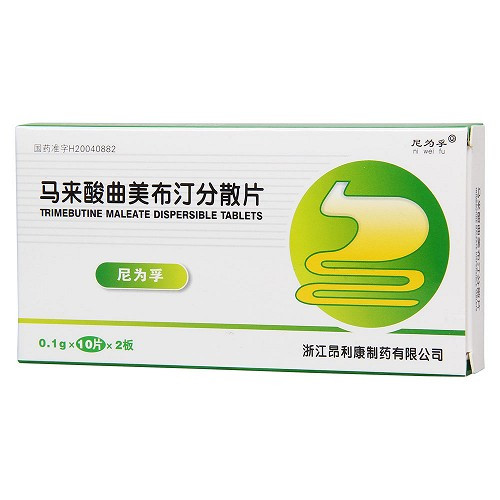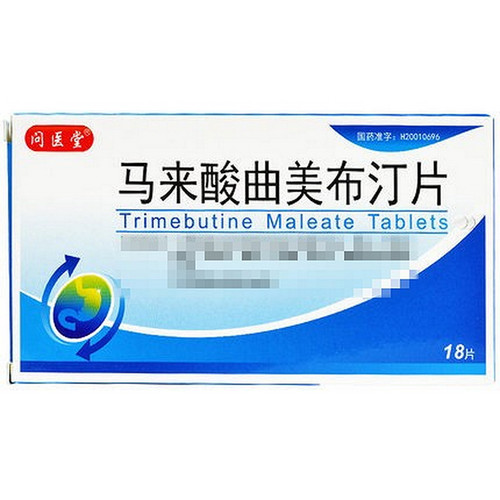Product Overview
[Drug Name]
Trade Name: Nuowei
English Name: Trimebutine Maleate Tablets
Chinese Pinyin: Malaisuanqvmeibuting Pian
[Ingredients]
Trimebutine Maleate (C22H29NO5C4H4O4).
[Appearance]
This product should be white or off-white tablets.
[Indications]
1. Relief of symptoms such as loss of appetite, nausea, vomiting, belching, abdominal distension, borborygmus, abdominal pain, diarrhea, and constipation caused by gastrointestinal motility disorders.
2. Irritable Bowel Syndrome.
[Dosage and Administration]
1. For chronic gastritis, take one tablet (0.1g) orally three times daily, or as directed by a physician.
2. For irritable bowel syndrome, take one to two tablets (0.1-0.2g) orally three times daily, or as directed by a physician.
[Adverse Reactions]
Occasionally, there may be thirst, oral numbness, abdominal borborygmi, abdominal distension, constipation, tachycardia, drowsiness, dizziness, headache, rash, and elevated glutamic-oxaline aminotransferase (GOT) and alanine aminotransferase (GPT), with an incidence of approximately 0.4%.
[Contraindications]
This product is contraindicated in patients allergic to trimebutine maleate.
[Precautions]
1. Use with caution in pregnant and lactating women and children.
2. Discontinue use and observe if a rash develops.
[Use in Special Populations]
Precautions for use in children: This product is not recommended.
Precautions for use during pregnancy and lactation: Use with caution.
Precautions for the Elderly: This product has not been tested and no reliable references are available.
[Drug Interactions]
Not yet known.
[Pharmacological Actions]
1. Effects on Digestive Tract Motility: 1) Gastric Motility Regulation: Addition of 10-5g/ml of this drug to isolated guinea pig gastric vestibular circular muscle specimens reduced the amplitude of their autonomic movements. Furthermore, it increased the frequency and amplitude of irregular, weak movements in the same specimen at 28°C, shifting them toward regular, rhythmic contractions. Intravenous injection of 3mg/kg of this drug into anesthetized dogs with thoracic vagus nerve transection regularized irregular gastric movements. Intravenous injection of 1mg/kg of this drug into the pyloric region of the stomach in patients with digestive system diseases has been shown to inhibit the movements of hyperkinetic muscles and enhance the movements of hypokinetic muscles. 2) Induction of Digestive System Propulsive Motility: Intrajejunal administration of 4-6mg/kg of this drug in humans has been shown to induce physiological propulsive motility in the adult digestive system. 3) Improvement of gastric emptying function: For patients with chronic gastritis who experience frequent, unexplained upper abdominal gastrointestinal discomfort, oral administration of 200 mg of this drug can improve decreased gastric emptying function and inhibit hyperactive gastric emptying. 4) Regulating intestinal motility. 5) In experiments on isolated guinea pig colon specimens, at a dose of 10-5 g/ml, it increased muscle tone in cases of low muscle tone (under low load) and reduced tone and amplitude in cases of hyperactive muscle tone (under high load). · Hypermotility of the large intestine caused by psychological exertion in allergic bowel syndrome can be inhibited by 300 mg of this drug. · In patients with hypermotility induced by neostigmine stress, intravenous administration of 50 mg can suppress motility in the ileum, ascending colon, and sigmoid colon to pre-stress levels. 6) Regulation of Lower Esophageal Sphincter Pressure (LESP) - Experiments on lower esophageal sphincter pressure in anesthetized dogs showed that intravenous administration of 0.6 mg/kg can reduce the increase in internal esophageal pressure caused by tetragastrin loading, while also recovering the decrease in internal pressure caused by secretin. 7) Direct Effects on Digestive Tract Smooth Muscle - Experiments on isolated guinea pig gastric vestibular circular muscle specimens revealed that this drug still has a direct effect on digestive tract smooth muscle even in the presence of atropine, phentolamine, propranolol, and tetrodotoxin. - Experiments on isolated guinea pig ileum revealed that this agent can non-competitively inhibit the contraction caused by acetylcholine. Furthermore, it was found that direct effects on digestive tract motility persist after vagus nerve removal in the chest of anesthetized dogs. 2. Peripheral Antiemetic Effect: Experiments in dogs have shown that while its inhibitory effect on apomorphine-induced vomiting is weak, it significantly prolongs the duration of vomiting induced by copper sulfate after intravenous injection of 3 mg/kg or oral administration of 60 mg/kg.
[Storage]
Store in a sealed container away from light.
[Specification]
0.1g x 20 tablets
[Packaging]
Box
[Expiry Date]
24 months
[Approval Number]
National Medicine Standard H20000390
[Manufacturer]
Company Name: Hainan Puli Pharmaceutical Co., Ltd.






